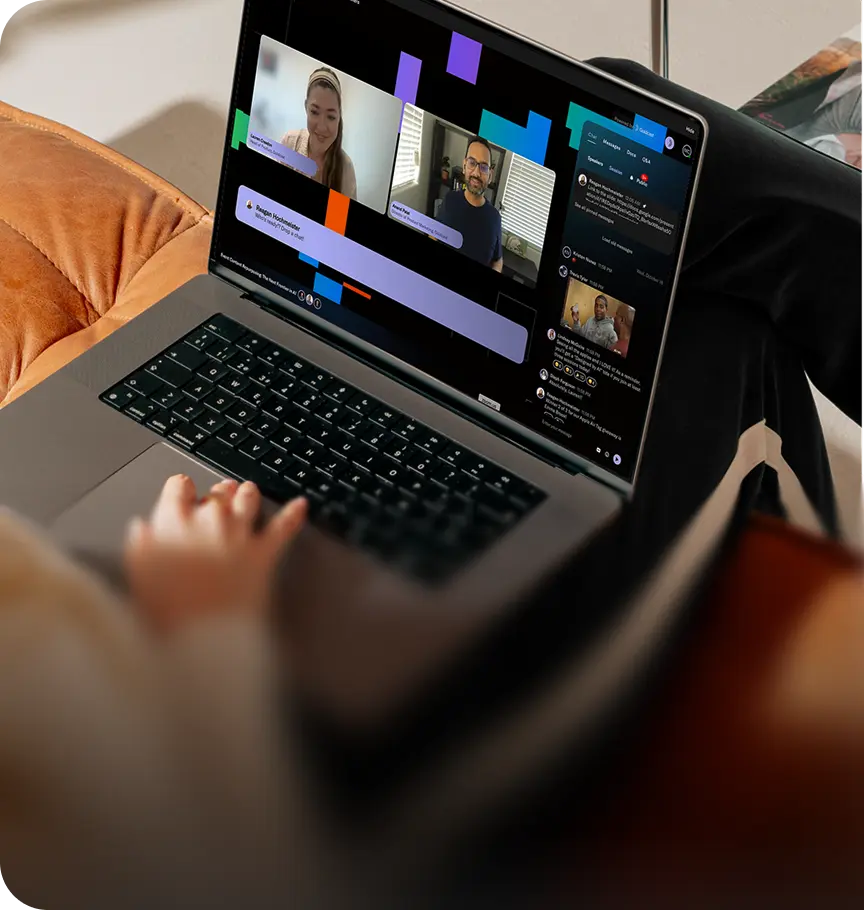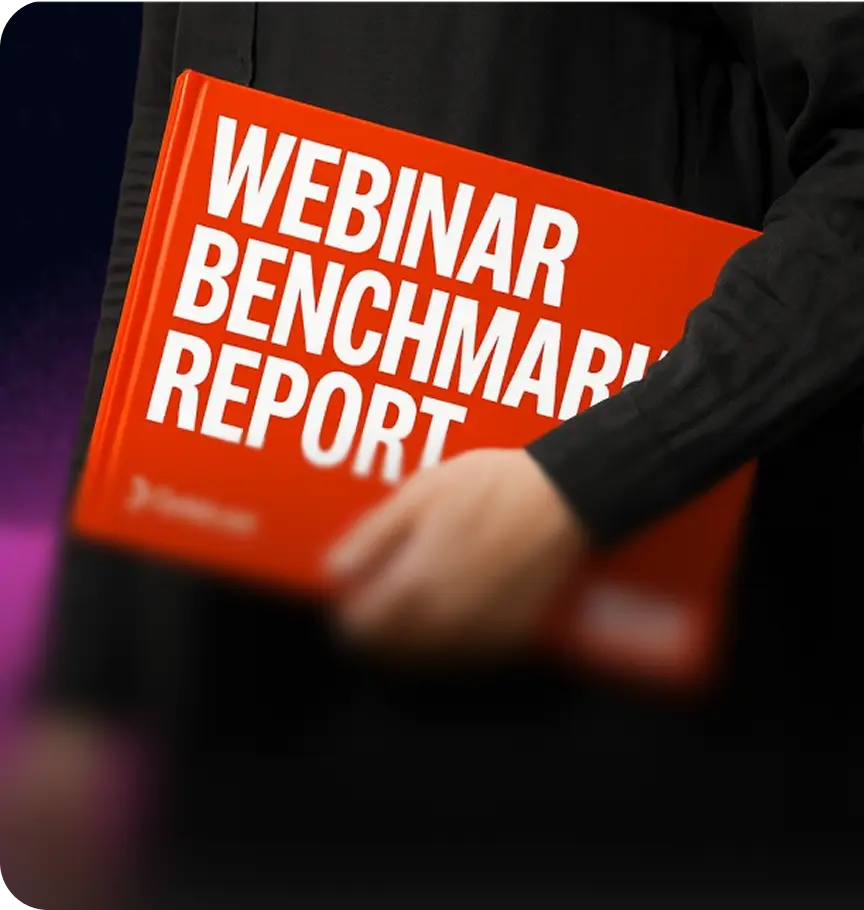B2B Video Production Guide: Create, Repurpose, Measure

Table of Contents
Maximize Your Marketing ROI
Join 10,000 other marketers already getting the best tips on running engaging events that boost pipeline and create raving fans.
Video isn't just another marketing channel anymore; it's a strategic imperative.
Lately, we've seen the conversation shift from talk about making videos here and there to building a scalable, predictable video content engine that builds genuine human connections and drives revenue forward.
According to research, over half (52%) of B2B marketers say that video yields the highest ROI of all types of content. Video helps potential customers understand your product, directly boosts sales, increases visitor time on your company website, and so much more.
In the B2B space, we aren't just focused on engagement metrics like views (though those are still nice to have). We're playing the long game, thinking about the now-standard lengthy sales cycles and how we're going to build trust with audience members over time with solid video content — without burning ourselves out.
The strategic foundation: Moving from ad-hoc videos to a content engine
In this video production guide, we'll provide a comprehensive framework for B2B video production, moving beyond basic tips to dive into strategy, unified production workflows, amplification, and what real ROI looks like. The strategic foundation: Moving from ad-hoc videos to a content engine
Many B2B companies approach video production like an individual campaign. They look at one video at a time, complete with its respective budget, timeline, and objective. This fragmented approach ultimately results in inconsistent messaging, wasted resources, and videos that exist in isolation rather than supporting your overall, long-term marketing goals.
Building a video content engine, on the other hand, requires a strategy-first approach. At every step, you're thinking of how to build a well-oiled system — never just a single video. Here are some steps to take to get there:
Define your "why." Establish specific, measurable objectives (think: SMART). We recommend setting specific outcomes that drive revenue: leads generated, sales enablement metrics, pipeline acceleration, customer retention, etc. This will help you assess your performance more clearly than more generic goals like "brand awareness" (although awareness and Mindshare are obviously part of the equation!).
Deep dive into your buyer personas. Effective B2B videos offer their target audience practical solutions that resonate and feel real. For example, a video aimed at C-suite decision-makers might emphasize strategic outcomes, while another video created for finance leaders talks about budget impact. Ask your sales team about the persona-specific concerns you should speak to; they'll know all about the top-asked questions, objections, and challenges.
Map video types to the B2B buyer's journey. Different types of video speak to different potential clients at each stage of the funnel. For awareness, use short, engaging explainer videos and thought leadership content. In consideration, deploy in-depth product videos, educational webinars, and case studies. And in the final decision stages, rely on customer testimonials and onboarding videos.
The modern B2B video production workflow
While many teams piece their videos together across disparate tools, Goldcast brings it all together, streamlining the most critical parts of the video production process and allowing you to more easily produce on-brand content, repurpose at scale, and track performance.
Here are our best tips on creating consistent, professional video content that covers the full lifecycle:
Pre-production: Set yourself up for success
In this phase, you'll define the purpose of your video, identify its intended audience, and get busy with scripting and storyboarding. Putting in the time to properly plan for your videos makes or breaks their future success!
Scripts should address specific pain points, include compelling statistics or real-life examples whenever possible, and conclude with a clear call to action that guides viewers toward desired next steps.
Storyboarding, on the other hand, is how you'll visualize your content flow and figure out where extra visuals, transitions, and branding elements can fit into your video.
Production: Capture high-quality, on-brand content
Production quality directly impacts audience engagement and brand perception. While you don't need to hire a full-service video agency, you do need to cover the basics when keeping things in-house.
- Equipment setup: Use a tripod to stabilize your camera (yes, you can use your smartphone!).
- Lighting: Check the room for the best natural light, or purchase affordable LED panels to ensure clarity and avoid harsh shadows.
- Audio quality: Clear sound is critical; invest in an external microphone since audiences drop off quickly if they hear poor audio.
Goldcast’s video production tools provide built-in professional capabilities, including high-quality local recording, backstage controls for speakers, and interactive elements like live chats and polls. These features enable a polished, TV-like experience without requiring a full production studio.
Post-production reimagined
Traditionally, post-production required laborious, manual-intensive tasks. Today, with the help of AI, you can dramatically reduce time spent while boosting quality.
This is the phase where you'll edit, polish, and (re) package content so it's ready to distribute:
- Editing: Trim footage, remove filler, and rearrange clips. You should also add captions and subtitles for accessibility and higher engagement. Tools like Goldcast Recording Studio make it simple to do all of that and more!
- Branding and visual callouts: Be sure that your aesthetic is consistent, including intros and outtros. Add in background music or sounds and animations to keep things visually clear and interesting.
- Ensure consistency across teams and contractors: If you do outsource any of the post-production work, be sure you have clear guidelines and templates in place so that things feel cohesive.
You must have a feedback loop with any relevant stakeholders so that video content is reviewed in a timely manner. Create checklists for quality control — things like audio sync, brand alignment, caption accuracy, etc — and be sure people know what type of feedback you're looking for. For example, if you want your leaders to watch and gauge for emotional reactions, tell them that so they know what to focus on.
Revolutionize post-prod with AI
Most video content has historically been "one and done" — the event would happen, and you'd never see the recording again, save for the on-demand graveyard. However, with AI, now you can automatically generate tons of valuable assets from that original recording.
Goldcast's Content Lab identifies the most compelling moments from your video and then, within seconds, creates social media clips, blog post drafts, email campaigns, and more. This dramatically multiplies content output while maintaining brand consistency.
In fact, Goldcast customers have seen results like this: 20x more content, delivered two weeks faster than their old processes, and a cost savings of $2,000 per clip. Just … wow.

Transform Your Event Recordings into Marketing Gold
Stop letting your event content collect digital dust. Goldcast's Content Lab turns a single recording into weeks of marketing material in just seconds.
A framework for distribution and amplification
Creating videos is only half the battle — next, you'll need a strategic distribution plan to be sure your videos are seen and shared.
Choose channels where your B2B audience lives
Be where your audience is. LinkedIn reigns supreme for B2B folks, offering sophisticated targeting features and an algorithm that currently prioritizes videos. (Video on LinkedIn has grown 45% YoY for good reason.) You should also hit YouTube for its SEO benefits and long-term content discovery.
And don't overlook email marketing and paid advertising. Videos in email and paid campaigns improve open rates, click-through rates, and engagement metrics; as a result, they're key components of a diversified distribution strategy.
Use high-production value and branding to boost engagement
There's a certain bar you want to meet when it comes to production value, but aim beyond it! Create memorable, TV-like experiences and brand videos. This makes your content more engaging and shareable, and people begin to trust you over time because they know you'll deliver a certain level of quality and expertise.
Goldcast allows for full brand customization, from landing pages to the virtual stage, enabling you to create cohesive experiences for attendees. Not only that, but you'll build brand recognition over time because people can tell at a glance when a piece of content (or an event) was created by you.
Turn a single long video into a full campaign
The majority (63%) of buyers say video drives their decisions — so serve them videos across platforms! The way to do that without burning your team out? Through systematic repurposing with a tool like Goldcast Content Lab.
Short, "snackable" clips taken from a longer event video are perfect for social media platforms, email newsletters, blogs, and more. People can visit your on-demand library if they want to view the entire recording, but push out the sizzle reel and the highlights so people understand the value of your events.
With repurposing, a single webinar or event recording turns into weeks (or more) of marketing material. This multi-asset approach extends reach across channels, boosting inbound traffic and SEO performance.
Measuring the ROI of your B2B video program
Measuring video ROI remains a major challenge, but you'll have to demonstrate value to justify investment and secure future budget.
Metrics that matter to the C-suite
Execs want to hear about metrics that tie directly to revenue generation and business growth, so show them! Track beyond views — think: click-through rates, watch time, and conversion rates. Paint a clear picture of how people who view your videos come to events, engage with your brand, and ultimately become customers.
Include deep engagement data as well. If someone attends an event and is highly interactive with your polls, clicks on a bunch of resources, and actively asks questions in the chat, that's a strong indicator of buying intent. (You should also be flagging these folks for sales to follow up with, stat.)
Goldcast tracks 16+ engagement data points per attendee, making it simple to keep the hottest leads on your radar. Plus, users report 10x faster speed-to-lead because of our platform's real-time sales alerts!
Connect video engagement to pipeline and revenue
Revenue generation is the holy grail of B2B video marketing, and modern platforms allow you to prove it by integrating directly with CRMs like Salesforce. From there, you can automatically attribute pipeline and revenue to your specific video marketing activities.
Integrations with CRM or MAPs allow you to identify which video content has the most impact on your deals. You can also see which accounts engage the most with videos and measure the correlation between video consumption and deal velocity. As a result, you have concrete evidence of video ROI.
Empowering sales and refining strategy
We touched on this a moment ago: Video data is most valuable when it enables your sales team to strike while the iron is hot. Real-time alerts when target accounts engage with certain videos allows sales reps to initiate timely, relevant conversations.
For example, if a prospect from a target account watches a specific product demo, sales can follow up afterward with related case studies or offer a personalized demo. This personalized approach improves speed-to-lead and conversion rates.
Elevate your B2B video production with an integrated platform
It's time to shift from a fragmented, project-based approach to a unified, scalable video content engine. To get there, you'll need a modernized B2B video platform like Goldcast that seamlessly brings all of the pieces together, from content creation to distribution and analytics.
Goldcast powers the entire video production lifecycle:
Video creation: We started as an events platform, and we're still the go-to for B2B marketers looking to produce high-quality, branded, interactive video experiences like webinars and podcasts.
Video amplification: Content Lab makes it easy to instantly turn long-form content into dozens of shorter clips, perfect for multi-channel distribution. You'll get the most value out of every video and be able to show up everywhere your audience is.
Video ROI measurement: Goldcast integrates with CRMs and other systems so you can connect video engagement directly to pipeline and revenue, justifying your budget and winning C-suite approval.
The days of treating video as a nice-to-have are long gone. With Goldcast, you can start building the scalable, ROI-driven video content engine your audience deserves. Get started below!
Ready to Build Your B2B Video Content Engine?
See how Goldcast streamlines everything, from video creation to ROI measurement. Join thousands of B2B marketers already scaling their video programs.
B2B video production FAQs
How much does B2B video production cost?
B2B video production pricing varies significantly; simple talking-head videos might cost $1,000-$5,000 when working with freelancers, while professional agency-produced videos can range from $10,000-$50,000 or more. However, modern AI-powered tools like Content Lab reduce costs by 80-90% by automating editing, repurposing, and optimization tasks that traditionally required expensive professional services.
How long should B2B videos be?
Optimal video length depends on platform and purpose, but short-form is usually best, with most marketers creating videos between 30-60 seconds. However, longer educational content performs well when it provides genuine value — webinars and detailed product demonstrations can effectively engage audiences for 30-60 minutes when properly structured.
What types of videos work best for B2B ROI?
Customer testimonials and case study videos are great choices because they provide social proof that influences purchase decisions. Product demos, thought leadership videos, and educational webinars also work well for B2B audiences. Finally, the more entertaining event-based content is excellent for repurposing!
How do you measure B2B video success?
Effective B2B video measurement focuses on business outcomes rather than vanity metrics. Track conversion rates from video engagement to qualified leads, pipeline progression for accounts that engage with video content, and revenue attribution for customers who consumed video during their buyer journey. Goldcast enables tracking of detailed engagement metrics that indicate genuine buying intent rather than passive viewing.
How can AI be used in video production?
AI tools like Content Lab transform B2B video production by automating time-intensive tasks while maintaining quality. Content Lab automatically generates captions and transcripts, identifies the most engaging moments in long-form videos for clip creation, optimizes content for different platform requirements, and more. According to Goldcast customers, using Content Lab can reduce video production time from hours to minutes while increasing content output by 10-20x!
Transform Your Video Marketing with AI
Stay In Touch
Platform
Resources
© 2025 Copyright Goldcast, Inc. All rights reserved.





 Upcoming Events
Upcoming Events Event Series
Event Series On-Demand Events
On-Demand Events

